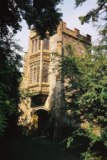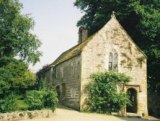Cerne Abbas, Dorset
Cerne Abbas is a small village in central Dorset. In 1998 it had a population of 780, that had fallen to 732 by 2001. The peace of such a small settlement could have been why it was voted Britain’s Most Desirable Village in 2001. (As my mother’s family comes from Cerne, it has always been a most desirable place for me!)
Abbot’s Hall Porch, Cerne Abbey (© Copyright Chris Downer and licensed for reuse under this Creative Commons Licence)
From earliest times, Cerne Abbey, founded in AD 987, was the cornerstone around which the village grew. The Domesday Book (1087) tells there was enough cultivated land for 20 ploughs and 26 villeins. The Abbey remained the focal point of the area for over 500 years until Henry VIII’s Dissolution of the Monasteries in 1539 brought about its surrender. Most of the buildings were destroyed, but the Abbot’s Porch and the Guesthouse still remain, as does St Augustine’s Well, blessed allegedly by the saint himself. The parish today is centred on St Mary’s Church which was built in the late 13th century by the Abbey for the local people.
Guest House, Cerne Abbey (© Copyright Chris Downer and licensed for reuse under this Creative Commons Licence)
Even after the Dissolution, Cerne was a popular market town, brewing being its drawcard because of the underground water that made quality beer. London loved it and it was an early export to the Americas. The population was then 1500 and a thirsty mob they must have been as there were 14 public houses serving them. The other small industries of silk weaving, millinery and tanning must have been thirsty work too.
When the railways began to arrive in the mid 19th century, Cerne was ignored and began to dwindle into the small village it is today, delighting tourists with its remaining three pubs, cafes and shops.
Cerne Abbas Giant (© Copyright Maurice D Budden and licensed for reuse under this Creative Commons Licence)
However the real talking point for visitors is the Cerne Giant, a 50 metre naked figure carved into the chalk hillside above the village. It is owned by the National Trust and thought to be an Iron Age fertility symbol – there is evidence of an Iron Age settlement nearby – but it is surprising that the monks did nothing to efface it. There is no record of the figures existence before the 17th century.
In 1754 Dr Richard Pococke wrote:
A low ridge of hills ends to the north of the abbey, on the west side of which is a figure cut in lines by taking out the turf and showing the white chalk. It is called the giant …, a naked figure … a sort of a Pantheon figure. In the right hand he holds a knotted club, the left hand is held out and open, there being a bend in the elbow so that it seems to be Hercules, or Strength and Fidelity, but it is with such indecent circumstances as to make one conclude it was also a Priapus. It is to be supposed that this was an ancient figure of worship, and one would imagine that the people would not permit the monks to destroy it.
Twenty years later John Hutchins wrote
There is a tradition that a giant who reside hereabout in former ages, the pest and terror of the adjacent country, having made an excursion into Blackmore and regaled himself with several sheep, retired to this hill and lay down to sleep. The country people seized this opportunity, pinioned him down and killed him, and then traced the outline of the dimensions of his body to perpetuate his memory.
With such enterprise in disposing of a “weapon of destruction” by the locals, maybe the monks felt it better to leave it alone.
For members and friends of The Richard III Society, of course, Cerne Abbey is where Queen Margaret of Anjou stayed on her way to Tewkesbury where her only son, Edward of Lancaster, Prince of Wales, was to meet his death. Her husband, the ineffectual Henry VI was already in London, installed in the Tower. Margaret had come from France where she had aligned with the renegade Earl of Warwick, and had landed at Weymouth only to learn that on that day Warwick had been killed at the Battle of Barnet.
It was at Cerne that she – and Edward’s wife, Warwick’s younger daughter Anne, who was later to become Richard III’s queen – found sanctuary behind the quiet walls and in the peaceful gardens of the Abbey.
Not for long though, Margaret being Margaret marched on at the head of the Lancastrian army to meet their fate. As the Yorkists now reigned supreme, she was allowed to cross the Channel once more to France where she ended her days.
When you visit the village of Cerne Abbas, view the giant by all means, buy souvenirs in the shops and enjoy a delicious cream tea in one of the tea-rooms. But make sure you pause for a time in the remains of the lovely Abbey and remember its role in the War of the Cousins. Remember Margaret, a fiercely determined queen and ambitious but loving mother determined to give her son what she thought was rightfully his.
And remember Anne, the frail young Neville daughter, who had been forced into a Lancastrian marriage, and who needed such a place to wonder what the rest of her life would hold.
Bibliography:
Bob Crawford, From Dorset with Love, Atmosphere, 1996. ISBN0952180 3 2: this book contains both the quotes by Dr Richard Pococke and John Hutchins. The Hutchins quote is probably from his History of Dorset, which came out in the late 18th century. No ISBN.
Sir Frederick Treves, Bart. GCVO, CB, LL.D, Highways and Byways of Dorset, Macmillan & Co. Ltd, 1906. No ISBN. (Interesting author: he was famous for taking charge of the case of the Elephant Man when no-one else wanted to help, and was sergeant surgeon to King Edward VII). His book has been a constant companion since I was eight and borrowed my grandfather’s copy, so probably Sir Frederick’s words have influenced mine.
Useful websites:
“Cerne Abbas”, Strolling Guides
“Cerne Abbas”, Wikipedia
“The Cerne Abbas Giant”, Mysterious Britain and Ireland
Tags: Anne Neville, Church, Margaret of Anjou




Leave a reply